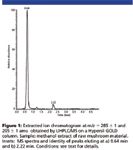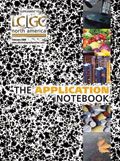Identification of Psychotropic Substances in Mushrooms by UHPLC/MS
The Application Notebook
Forensic laboratories face a daunting task to identify trace amounts of controlled substances in small samples of seized evidence. Unambiguous identification is required to meet the stiff challenge that is sure to be raised in the courtroom. Positive proof is especially difficult to establish if the controlled substance is hidden in a complex food matrix with a high content of sugars, fats, fatty acids, proteins, and alkaloids.
Forensic laboratories face a daunting task to identify trace amounts of controlled substances in small samples of seized evidence. Unambiguous identification is required to meet the stiff challenge that is sure to be raised in the courtroom. Positive proof is especially difficult to establish if the controlled substance is hidden in a complex food matrix with a high content of sugars, fats, fatty acids, proteins, and alkaloids.
To meet this challenge ultra high pressure liquid chromatography–mass spectrometry (UHPLC–MS) is preferred when the analytes are nonvolatile, thermally labile, or when gas chromatography (GC) can only be used after multistep sample clean-ups.
This application note demonstrates how a working forensic laboratory uses UHPLC–MS to analyse seized evidence for illegal hallucinogens. Two compounds are targeted; psilocin and psilocybin. Psilocin is the main psychoactive compound, and psilocybin is enzymatically dephosphorylated in the body to produce psilocin. GC cannot readily differentiate psilocybin from psilocin because psilocybin is thermally labile and dephosphorylates at high temperature. UHPLC–MS offers the benefits of simpler sample prep and positive identification of intact psilocybin and psilocin.

Figure 1
Experimental Conditions
Standard and Sample Preparation
Psilocybin and psilocin standards (Alltech, State College, PA) were combined and diluted to 50 ppb with methanol. The psilocybin mushrooms were WSP training samples. A mixture of 2 mL methanol and 10 mg of dried mushroom was vortexed for 30 s, filtered through a cotton-plugged Pasteur pipette, centrifuged for 90 s, filtered through 0.45 μm nylon syringe filter and diluted 50-fold with methanol prior to analysis.
Chromatographic Conditions
Instrument: Thermo Scientific Accela UHPLC system with Xcalibur 2.05
Column: Hypersil GOLD PFP 1.9 μm, 100 × 2.1 mm
Column Temp.: 45 °C
Flow Rate: 1 mL/min
Mobile phase: A: Water with 0.06 % acetic acid
B: Acetonitrile (ACN) with 0.06% acetic acid
C: Methanol with 0.06% acetic acid

Injection volume: 2 μL partial loop injection from 25 μL sample loop
Mass Spectrometer Conditions
Instrument: Thermo Scientific MSQ Plus with Xcalibur 2.05
Ionization: Electrospray (ESI)
Polarity: Positive
Probe Temperature: 500 °C
Cone voltage: 90 V
Scan Mode: Full scan with mass range of 100-400 m/z
ESI Voltage: 3.5 kV
Scan Time: 0.2 s
Results
Authentic mushroom samples were prepared as described above and the filtered extracts analyzed by using UHPLC–MS. The peaks eluting at 0.64 and 2.22 min in Figure 1 were tentatively identified as psilocybin and psilocin by comparison with the retention time of standards. The peaks were confirmed as psilocybin and psilocin by comparing sample and reference mass spectra. Each spectrum showed the molecular ion (m/z 285 and m/z 205 for psilocybin and psilocin, respectively) and a distinctive fragmentation pattern.
Conclusion
UHPLC–MS can positively identify trace amounts of the hallucinogens psilocybin and psilocin in dried mushroom samples in 5 min, after a simple 10 min sample prep involving no chemical derivatization.

Thermo Fisher Scientific, Inc.
355 River Oaks Parkway, San Jose, CA 95134-1991
tel. (800)532-4752, fax (561)688-8731
Website: www.thermo.com


.png&w=3840&q=75)

.png&w=3840&q=75)



.png&w=3840&q=75)



.png&w=3840&q=75)














